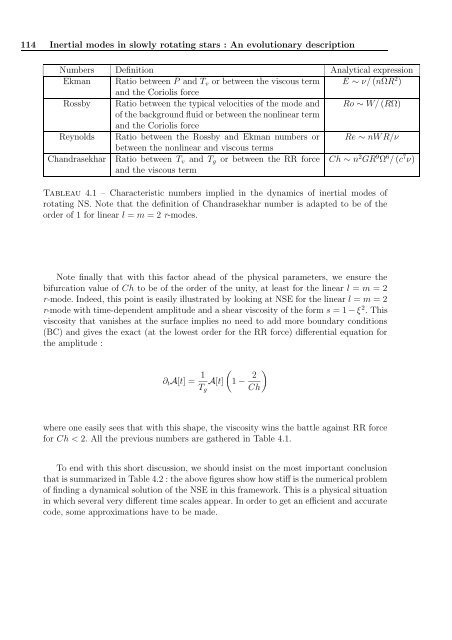Ecole doctorale de Physique de la région Parisienne (ED107)
Ecole doctorale de Physique de la région Parisienne (ED107)
Ecole doctorale de Physique de la région Parisienne (ED107)
Create successful ePaper yourself
Turn your PDF publications into a flip-book with our unique Google optimized e-Paper software.
114 Inertial mo<strong>de</strong>s in slowly rotating stars : An evolutionary <strong>de</strong>scription<br />
Numbers Definition Analytical expression<br />
Ekman Ratio between P and Tv or between the viscous term<br />
and the Coriolis force<br />
E ∼ ν/ (nΩR2 )<br />
Rossby Ratio between the typical velocities of the mo<strong>de</strong> and<br />
of the background fluid or between the nonlinear term<br />
and the Coriolis force<br />
Ro ∼ W/ (RΩ)<br />
Reynolds Ratio between the Rossby and Ekman numbers or<br />
between the nonlinear and viscous terms<br />
Re ∼ nW R/ν<br />
Chandrasekhar Ratio between Tv and Tg or between the RR force<br />
and the viscous term<br />
Ch ∼ n 2 GR 9 Ω 6 / (c 7 ν)<br />
Tableau 4.1 – Characteristic numbers implied in the dynamics of inertial mo<strong>de</strong>s of<br />
rotating NS. Note that the <strong>de</strong>finition of Chandrasekhar number is adapted to be of the<br />
or<strong>de</strong>r of 1 for linear l = m = 2 r-mo<strong>de</strong>s.<br />
Note finally that with this factor ahead of the physical parameters, we ensure the<br />
bifurcation value of Ch to be of the or<strong>de</strong>r of the unity, at least for the linear l = m = 2<br />
r-mo<strong>de</strong>. In<strong>de</strong>ed, this point is easily illustrated by looking at NSE for the linear l = m = 2<br />
r-mo<strong>de</strong> with time-<strong>de</strong>pen<strong>de</strong>nt amplitu<strong>de</strong> and a shear viscosity of the form s = 1 − ξ 2 . This<br />
viscosity that vanishes at the surface implies no need to add more boundary conditions<br />
(BC) and gives the exact (at the lowest or<strong>de</strong>r for the RR force) differential equation for<br />
the amplitu<strong>de</strong> :<br />
∂tA[t] = 1<br />
Tg<br />
<br />
A[t] 1 − 2<br />
<br />
Ch<br />
where one easily sees that with this shape, the viscosity wins the battle against RR force<br />
for Ch < 2. All the previous numbers are gathered in Table 4.1.<br />
To end with this short discussion, we should insist on the most important conclusion<br />
that is summarized in Table 4.2 : the above figures show how stiff is the numerical problem<br />
of finding a dynamical solution of the NSE in this framework. This is a physical situation<br />
in which several very different time scales appear. In or<strong>de</strong>r to get an efficient and accurate<br />
co<strong>de</strong>, some approximations have to be ma<strong>de</strong>.
















